Explore web search results related to this domain and discover relevant information.
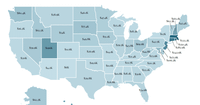
When it comes to purchasing land in the United States, there are significant variations in prices across different states. Some of the cheapest states to buy land are Arizona with a median price of $4,164 per acre, followed by New Mexico at $6,000 per acre. Mississippi, Colorado, and Arkansas ...
When it comes to purchasing land in the United States, there are significant variations in prices across different states. Some of the cheapest states to buy land are Arizona with a median price of $4,164 per acre, followed by New Mexico at $6,000 per acre. Mississippi, Colorado, and Arkansas also offer relatively affordable land with […]This can be attributed to factors such as population density, regional economic conditions, and demand for land. For instance, states like Texas, Georgia, and Florida offer land at relatively affordable prices, ranging from $29,818 to $34,900 per acre, despite their larger populations and robust economies.The ten states with the cheapest land are Arizona, New Mexico, Mississippi, Colorado, Arkansas, New York, Missouri, Oregon, Alabama, and Michigan. Arizona is the cheapest state to buy land with a median price of $4,164 per acre. New Mexico is the second cheapest state to buy land with a median price of $6,000 per acre.Mississippi has the third cheapest land in the US with a median price of $10,835 per acre. Colorado is the fourth state with the cheapest land with a price of $11,561 per acre, while Arkansas is close behind at $11,596 per acre. New York has a median price of $12,027 per acre, making it the sixth cheapest land in the US.
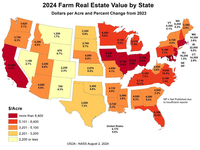
The value of all farm real estate increased to an average of $4,170 per acre. Cropland value increased to an average of $5,570 per acre from the previous year.
Farmers paid an average of $160 per acre to rent cropland, but rents on irrigated ground averaged $245 per acre while dryland rents averaged $146 per acre. To compile its annual Land Values Summary, USDA uses a sample of 9,000 segments of land, each about a square mile in size.The agency's enumerators contact all producers in that segment to record cropland and pastureland values. They also collect an estimate of all land and buildings in the farmer's entire operation as well as percentage change from the prior year.NASS also released "Quick Stats" details showing average cash rents per state for 2024. Nationally, the average cash rent this year is $160 an acre, up $5 from 2023. The average irrigated cash rent came in at $245 an acre, up $8 an acre from 2023. ... You can find the entire Land Values Summary report, with state-by-state breakdowns, here: https://downloads.usda.library.cornell.edu/…The national average value of farm real estate climbed to $4,170 per acre in 2024, an increase of 5%. (Map Courtesy of USDA)
Cropland values are higher than pastureland values in every region. In the Pacific region, the average cropland value per acre ($9,520) was more than four times higher than the average pastureland value per acre ($2,370) in 2024. Another measure of value is the annual rental cost of using land ...
In addition to differences in the value of land, farm real estate growth varies by region. While farm real estate values increased in all economic regions between 2023 and 2024 (after adjusting for inflation), real growth ranged from a zero percent change in the Pacific region to a 6.8 percent increase in the Southeast.Cropland values are higher than pastureland values in every region. In the Pacific region, the average cropland value per acre ($9,520) was more than four times higher than the average pastureland value per acre ($2,370) in 2024. Another measure of value is the annual rental cost of using land for agricultural production.Farm real estate (land and structures) accounted for a forecasted 3.52 trillion dollars (83.5 percent) of the total value of U.S. farm assets in 2024.Over the previous 5-year period (2018 to 2023), the average annual growth rate was highest in the Pacific region (3.2 percent) and rose the least in the Appalachian region (0.3 percent).
A country’s overshoot day is the date on which Earth Overshoot Day would fall if all of humanity consumed like the people in this country.
The Country Overshoot Day 2025 calendar shows the dates by which humanity would have used up everything Earth can renew for that year, if all people consumed at the level of that country.Agricultural area data: Updates to grazing land and cropland statistics from the UN FAO ResourceStat.Not all countries have an overshoot day, though. If a country’s Ecological Footprint per person is smaller than global biocapacity per person (1.5 gha), then the world would not use up the entire regenerative resource budget for the year within a year, if all humanity lived like them.If a country’s Ecological Footprint per person is smaller than global biocapacity per person (1.48 gha), humanity would not exceed the planet’s regenerative capacity within a year if everyone consumed like that country.

Description: Land used for cultivation of crops and animal husbandry. The total of areas under ''Cropland'' and ''Permanent meadows and pastures.''
Food and Agriculture Organization of the United Nations - Land, Inputs and Sustainability: Land Use (2024). All data and visualizations on Our World in Data rely on data sourced from one or several original data providers. Preparing this original data involves several processing steps. Depending on the data, this can include standardizing country names and world region definitions, converting units, calculating derived indicators such as per capita measures, as well as adding or adapting metadata such as the name or the description given to an indicator.You have the permission to use, distribute, and reproduce these in any medium, provided the source and authors are credited. To cite this page overall, including any descriptions, FAQs or explanations of the data authored by Our World in Data, please use the following citation: “Data Page: Agricultural land use per capita”, part of the following publication: Hannah Ritchie, Pablo Rosado, and Max Roser (2023) - “Agricultural Production”. Data adapted from Food and Agriculture Organization of the United Nations.Description: Land used for cultivation of crops and animal husbandry. The total of areas under ''Cropland'' and ''Permanent meadows and pastures.''This dataset contains data on 44 categories of land use, irrigation and agricultural practices and five indicators relevant to monitor agriculture, forestry and fisheries activities at national, regional and global level.
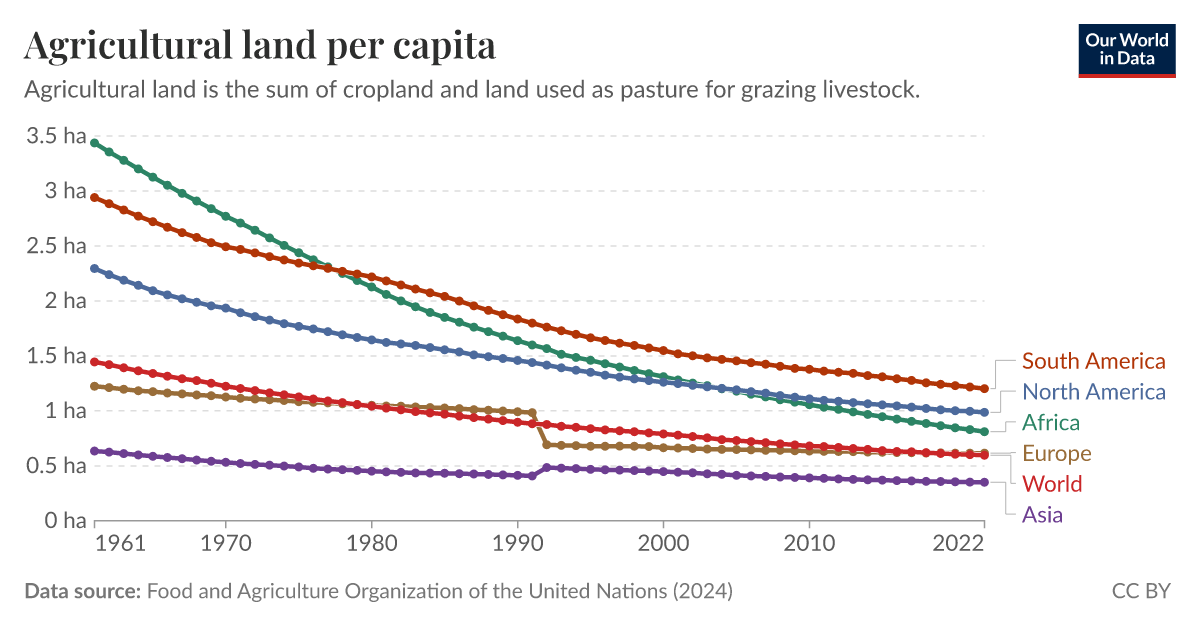
The cost of land per acre varies greatly depending on location and intended use. On average, in the United States, the cost of one acre of land is around $18,000.
You can buy an acre for under $1,000 in some places, but some commercial lots and farmland can exceed $100,000 per acre. Land values are determined by factors such as access to utilities, infrastructure, and zoning regulations.Listing data shows that you can find the cheapest land in Arizona and New Mexico, but low-cost land is for sale throughout many rural areas and small towns in other states like Wyoming, North Dakota, Nevada, West Virginia, Texas, and even California. Prices can be as low as a few hundred dollars per acre with factors like accessibility, infrastructure, local economy, and property condition influencing the price and desirability of the land.You'll find the most expensive U.S. land in areas with high demand and limited availability, such as Manhattan, San Francisco, Beverly Hills, and major cities with booming real estate markets. Listing data shows that the most expensive states by price per acre include New Jersey, Rhode Island, Delaware, and Hawaii.The cost of land per acre varies greatly depending on location and intended use. On average, in the United States, the cost of one acre of land is around $18,000.

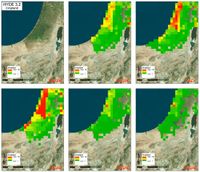
They have historically relied on unsophisticated assumptions about the temporal and spatial variability of the area needed to support one person: per capita land use (PCLU). To help refine ALCC models, we used a range of data sources to build a new database that attempts to bring together PCLU ...
Anthropogenic land cover change (ALCC) models, commonly used for climate modeling, tend to utilize relatively simplistic models of human interaction with the environment. They have historically relied on unsophisticated assumptions about the temporal and spatial variability of the area needed to support one person: per capita land use (PCLU).To help refine ALCC models, we used a range of data sources to build a new database that attempts to bring together PCLU data with significant time depth and a global perspective. This new database can provide new nuance for our understanding of the variability in land use among and between time periods and regions, data that will have wide applicability for continued research into past human land use and present land-use change, and can hopefully help improve existing ALCC models.Historical models of anthropogenic land cover change (ALCC models) are commonly used in climate modeling [3,10,11,12] and are generally constructed based on published estimates of past population combined with estimates of land-use requirements per person, or per capita land use (PCLU) [11]. While there are ALCC models covering the last several thousand years [1,2,3], these models have been constrained by uncertainties in population data and by the limited availability of per capita land-use (PCLU) values applicable to different time periods, regions, subsistence strategies, and societies.ALCC models rely on PCLU estimates to reconstruct land-use change through time. They do this by multiplying population estimates by the area supposedly needed to support each person in the population, i.e., a PCLU value.

Land is listed per acre to show value clearly and account for survey adjustments and quantity discounts — the more you buy, the lower the price per acre!
The standard response is that a Seller would not be interested in selling such a small tract of land. The administrative costs and the potential loss of road frontage and access are the main reasons for a Seller to be discouraged from such a small sale. For example, of that 9,753 acres we mentioned, how much of it has access or frontage? If a tract that large already has limited access, a Seller would not be inclined to sell off more acreage; therefore, further limiting his access. Typically, acreage is listed at a per acre price to notify potential Buyers of the per acre price.Have you noticed that most residential neighborhood lots may sell for $5,000 -$30,000 depending on the size of the lot and that lot may not even be the size of one acre? But you can find 150 acres for approximately $2,000-$3,000 per acre. There are instances where a tract may be divided into smaller portions, but those divisions are still dependent on access. No one wants to be left with a landlocked tract.It is the industry standard for valuing land instead of by total price. A Buyer enjoys the luxury of knowing the per acre price versus the total sales price. Most Buyers will do the calculations themselves.Those are typically hard to sell unless there’s an adjoining landowner who might be interested.
At the New York Fed, our mission is to make the U.S. economy stronger and the financial system more stable for all segments of society. We do this by executing monetary policy, providing financial services, supervising banks and conducting research and providing expertise on issues that impact ...
An interactive visualization from Our World in Data.
Dietary land use vs. GDP per capitaPig production: Land use vs.Share of global habitable land needed for agriculture if everyone had the diet of...
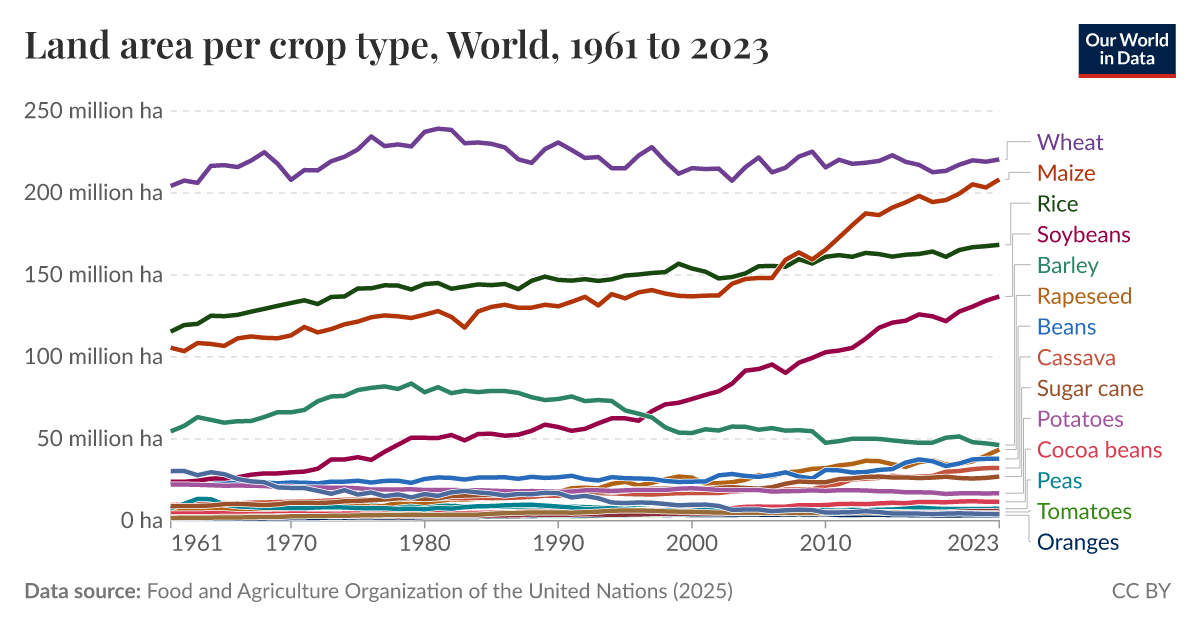
Arable land (hectares per person) from The World Bank: Data
Agricultural land (sq.Land area (sq.Rural land area where elevation is below 5 meters (% of total land area)Urban land area where elevation is below 5 meters (% of total land area)

This is a list of countries and dependencies ranked by population density, sorted by inhabitants per square kilometre or square mile. The list includes sovereign states and self-governing dependent territories based upon the ISO standard ISO 3166-1. The list also includes unrecognized but de ...
This is a list of countries and dependencies ranked by population density, sorted by inhabitants per square kilometre or square mile. The list includes sovereign states and self-governing dependent territories based upon the ISO standard ISO 3166-1. The list also includes unrecognized but de facto independent countries.

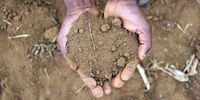
A cup of coffee costs four square metres of land. A taxi within a city costs 150 square metres. A laptop cost 10 square metres. The estimated value of ecosystem losses – as a result of land degradation – is between 850 and 1400 USD per year for every one of us on the planet.”
Rehabilitating the nearly 500 million hectares of abandoned agricultural land would help achieve Sustainable Development Goal target 15.3, and provide food security and economic opportunities. The report claims that this land can be rehabilitated for an average price of less than 200 Euros per hectare.The Economics of Land Degradation Initiative, an SEI partner, launches key report at the 70th United Nations General Assembly.The report, titled The Value of Land, is a comprehensive assessment of land degradation and sustainable land management.The report notes that 24% of the world’s productive lands are degraded, causing food insecurity, poverty, lack of clean water, and increased vulnerability in areas affected by climate change.
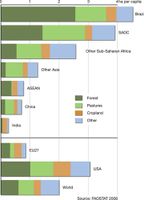
The amount of land area available per capita provides a rough measure on the current carrying capacity for food security and for the development of additional agricultural products for export – such as biofuels. The calculation presented in this figure show that most of Asia is very limited ...
The amount of land area available per capita provides a rough measure on the current carrying capacity for food security and for the development of additional agricultural products for export – such as biofuels. The calculation presented in this figure show that most of Asia is very limited in this respect, especially since populations are expected to increase.Graphic Environment and P... The development potential - available land per capita, in land use classUsing this item and referring to it is encouraged, and please use it in presentations, web pages, newspapers, blogs and reports. For any form of publication, please include the link to this page and give the creator credit (in this case Hugo Ahlenius, UNEP/GRID-Arendal) If the high-resolution file is not available, please contact [email protected] for request and permission for usage.
Total land area in square kilometres Per capita figures expressed per 1,000 population.
DEFINITION: Total land area in square kilometres Per capita figures expressed per 1,000 population.Greenland ranked first for area > land > per capita amongst Christian countries in 2005.Western Sahara ranked first for area > land > per capita amongst Hot countries in 2008.Iceland ranked first for area > land > per capita amongst Europe in 2008.
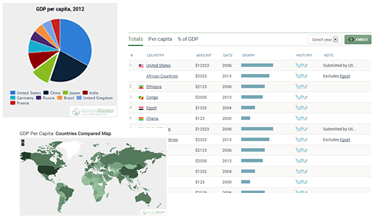
Short for “percolation test,” this soil test decides if your land can support a septic system. Without a passing result, you might not be legally allowed to build at all. Even if the property looks perfect.
A perc test (short for percolation test) checks how quickly water drains through your soil. It’s one of the most important tests for land buyers, especially in rural areas with no city sewer access. A passing result means the land is suitable for installing a septic system.Related: What Is Land Development? Process, Costs, Types & Examples · A failed perc test doesn’t automatically mean the land is useless, but it does mean big decisions ahead.There’s no guaranteed way to “pass” a perc test, but you can improve your chances. · Avoid compacting the soil before testing (no driving heavy vehicles). · Test during dry conditions if your county allows it. · Clear any vegetation, roots, or debris from the test area. · Choose larger lots that allow flexibility in septic placement. · Tip: Even if one test site fails, another location on the lot might pass. If your land fails the perc test, don’t panic.If you’re buying land to build a home, then there’s one step you can’t afford to skip: the perc test.
Arizona has the lowest cost per acre in the U.S. The average cost per acre is $4,200. The state with the most expensive vacant land is Rhode Island where an acre of land costs $350,400.
Arizona has the lowest cost per acre in the U.S. The average cost per acre is $4,200. The state with the most expensive vacant land is Rhode Island where an acre of land costs $350,400.Of course, many questions influence the value of land. The big ones are: ... The ‘small’ states in the northeast are some of the most expensive price-per-acre states in the country.Selling land in one of these ‘cheap’ states can be a lot easier compared to our friends in the Northeast. A lower price per acre means more buyers can afford to buy your land.Tell us about the land you want to sell and we’ll send your property’s information to 12 individual land buyers. Get cash offers for your land sent to your email. Credit Zippia.com for the cost per acre data.

Texas land prices can vary by region. The current price per acre is over $4,600/acre. This guide will show your price data specific to your region.
There are seven different market regions throughout Texas when it comes to rural land: Panhandle and South Plains, Far West Texas, West Texas, Northeast Texas, Gulf-Coast – Brazos Bottom, South Texas, and Austin – Waco – Hill Country. Throughout those regions, the range in prices per acre is just about as wide as Texas itself.If you’re in the Dallas-Fort Worth area searching for land nearby, for example, you might pay more than other regions in Texas. Land in Northeast Texas goes for roughly $8,200 per acre, according to the latest Texas Land Market Latest Developments Report..The amount you’ll pay for an acre of land in Texas could also partially depend on what kind of acre it is. According to the USDA, the average value of Texas cropland in 2024 was higher than the average value of Texas pastureland (by about $400/acre). You’re likely to find some of the cheapest Texas acres in the Panhandle and South Plains region, or in Far West Texas. Although price per acre has still been increasing in the Panhandle and South Plains, you could still find land there for an average of $1,890 per acre.Prices for land in West Texas are also still holding steady in the triple digits per acre.
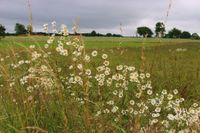
Götene, which is about 200 miles from Stockholm, is selling plots of land with prices starting at just about nine cents.
Götene, about 200 miles from Stockholm, is selling plots of land starting at 1 krona per square meter or nine US cents per 10 square feet.Buyers must build a home on the land with plans to either live there permanently or use it as a vacation property, according to CNN.CNN reports that when Götene starts selling off land again, it is likely there will be a bidding process instead of just selling the plots at that low price of 1 krona per square meter."We have a lot more land, and we'll have to sit down and see if we can do something to make something more of it other than just these 30 plots. We need something to offer the callers," he told CNN. Månsson said this program has brought hope to the town. "If you're seeking a quiet life in the country, we can bring you a high quality of life," he said. "It's the perfect match."

USDA National Agricultural Statistics Service’s annual Land Values report has been published, and farm real estate values vault upward once again. In 2025, agricultural land is valued at an average of $4,350 per acre, a 4.3% jump since last year, and more than double the 2010 value reported ...
USDA National Agricultural Statistics Service’s annual Land Values report has been published, and farm real estate values vault upward once again. In 2025, agricultural land is valued at an average of $4,350 per acre, a 4.3% jump since last year, and more than double the 2010 value reported at $2,150 nationwide.Primary surveys are conducted in early June, and farm real estate values measure the value of all land and buildings on farm. Reported values for cropland and pasture are also included, both of which reached record highs. Cropland averaged $5,830 per acre, up $260 from 2024, rising by $510 in the last two years.Rounding out the largest percentage increases is a rapidly growing dairy region, South Dakota, with a 6.8% spike in the Mount Rushmore State. Average real estate values did not decline in any state, but the lowest growth was shown in Connecticut at a 0.7% rise. Once again, the Northeast, the most densely populated region of the nation, leads the country in real estate land values.The combination of high yields and limited availability is showing reported land values reaching new levels in regions of the country that have historically been more isolated from drastic growth.






